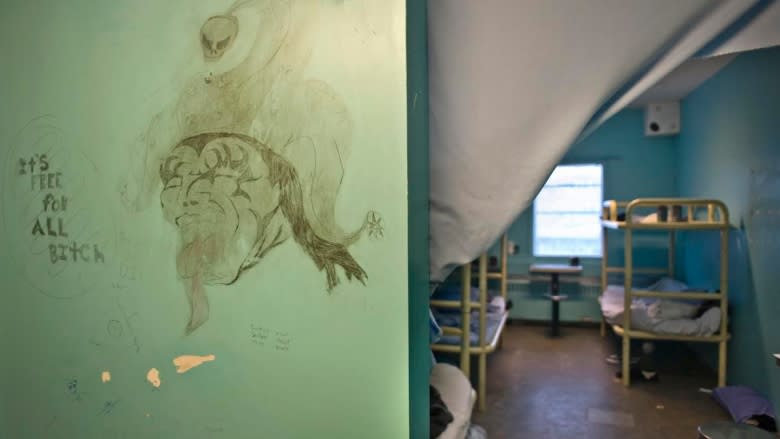Say goodbye to 'appalling' Nunavut prison: Plan to replace Baffin Correctional Centre by 2021
Called a "cardboard prison" and "nothing short of appalling," Iqaluit's notorious Baffin Correctional Centre has been thoroughly condemned by everyone from judges and lawyers to Canada's auditor general and the federal Office of the Correctional Investigator.
Now the Nunavut government says residents should prepare to say "bye, bye, BCC."
In 2015, the Auditor General of Canada issued a damning report slamming Nunavut's correctional facilities and especially Baffin Correctional Centre for overcrowding, lack of programming for inmates and risking the safety of inmates and staff.
It's not being demolished, but if all goes according to plan, the Baffin Correctional Centre will soon be renovated, rebuilt and rebranded as the Qikiqtani Correctional Healing Centre.
"We're investing," said Keith Peterson, Nunavut's minister of justice and finance.
"We'll improve programming so that we can help those who are in jail, so that when they return to their communities they will hopefully be able to reintegrate into the community."
Although the territory has not yet hired an architect to design the project, initial plans show a much larger facility — nearly 60,000 square feet, including storage and outbuildings, and space for 112 beds, if all the medium- and maximum-security cells are double bunked.
Current facility puts lives at risk
The renovations are urgently needed, both for financial and safety reasons.
"Simply stated, the current situation at BCC is dire," states a 2015 business case written for the government by engineering and design firm Stantec.
"Growth in inmate populations without corresponding growth to BCC has resulted in severe overcrowding and costly relocation of inmates to institutions in other jurisdictions."
The document states frankly that delaying the renovations would threaten the "life safety of staff, inmates and community."
"Without appropriate housing for maximum security offenders, both staff and offenders are continuously subjected to increased risk," it said.
Peterson agrees the building, as it stands, is as bad as numerous reports have outlined.
"Those stories are true," he said. "My concern there is that it's a danger to not only the inmates in the facility, but also our hard-working staff. Every day they're exposed to personal danger by being in a facility that's not up to modern standards."
According to the Stantec report, "serious incidents are occurring at an alarming and increasing rate."
Lack of maximum-security building a danger
When the Baffin Correctional Centre was built nearly 30 years ago, it was designed as a minimum-security facility for 41 inmates.
Chris Stewart, manager of capital and special projects for Nunavut's Department of Justice, says BCC was "built for a different time."
Its design was the brainchild of well-known architect Bruno Freschi.
"It was, relatively speaking, a small building," said Freschi in an interview last year, describing its bright skylight and open space for learning.
"As a correctional facility, you're really expecting people to go in and come out and become really functional members of the community," he said.
"To the best of my knowledge, it was working well after it opened."
But when the inmate population surged in the 1990s, things evidently changed. After a security upgrade in 1996, the capacity was increased to 66 beds with two segregation cells.
By the 2000s, the bed count was routinely higher than 75 with a peak in the midwinter of 115 inmates in cells and the gymnasium, which was re-purposed into a makeshift sleeping area.
In 2014, Howard Sapers, with the Office of the Correctional Investigator, called the jail "appalling" and called for it to be shut down.
Sapers puts the Baffin Correctional Centre on par with some of the worst jails he's seen around the world.
"I have visited prisons across Canada and in several spots in the United States and in many places around the world, including China, (South) Korea, the Czech Republic, Singapore," he said.
The stress on the BCC has been lessened with the opening of the Makigiarvik Correction Centre next door and its emphasis on providing rehabilitative programming for minimum-security prisoners, say Peterson and Stewart.
Right now, Peterson says the number of prisoners in BCC is in the mid-50s.
But with the facility in disrepair, the business case says "occupancy at the BCC today should be a maximum 33 inmates."
Bringing home inmates
The overcrowding problem is so extensive, the Nunavut government spends more than $4 million to house inmates outside of the territory — predominantly in Ottawa and Yellowknife. This project will bring them home.
"This is extremely important to us," said Stewart.
"We recognize that inmates serving their sentences outside of the territory have very little access to culturally appropriate programming, access to family and support groups that are going to be so vital to them once they are released."
Complicating matters is that outside facilities take only the most leniently sentenced inmates, who might arguably take best advantage of culturally appropriate programming.
"BCC services the toughened criminals," the government's business plan for the new jail states.
"Inmates who return from outside the territory are hardened by the experience and bring that negative influence home with them."
Together with a lack of programming caused by the re-purposing of recreational space to bed space, "the situation serves to increase recidivism promoting an upwardly spiralling cycle of crime and incarceration."
A $76-million price tag
Despite the negative connotations associated with the BCC, the department says keeping the structure of the facility will save money.
"We made sure we were using existing resources and being innovative and to make sure we keep costs down," said Stewart.
A maximum-security addition likely will be built directly behind the Baffin Correctional Centre and the existing structure will be extensively renovated.
The territory hopes to begin construction of the new wing in the summer of 2018 and start renovations on the existing building in 2020, with a substantial amount of work to wrap up by September 2021.
Over the next five years, the total cost of construction, design and planning for the new Qikiqtani Correctional Healing Centre is pegged at $76 million.
The territorial government has applied to Infrastructure Canada for 75 per cent of that amount and is waiting for final approval from the Treasury Board of Canada.



